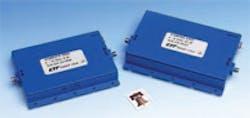GaN Power Amplifiers Include Thermal Protection
Gallium nitride (GaN) was the semiconductor "material of the moment" at IMS 2011. Not to be overlooked, CTT, Inc. announced their AGM series of GaN power amplifiers for industrial and military applications from 2 to 18 GHz. With power levels to 40 W at microwave frequencies, these solid-state amplifiers are compact alternatives to traveling-wave-tube amplifiers.
The AGM and AGW series of GaN amplifiers (see figure and table) are literally designed to "get the heat out." One of the issues faced by amplifier designers working with GaN devices is the high power density of each device. The amount of heat dissipated is simply beyond the thermal capabilities of many microwave printed-circuit-board (PCB) substrate materials.
The AGM and AGW series amplifiers, which are designed around devices from leading GaN discrete transistor and monolithic-microwave-integrated-circuit (MMIC) suppliers, including Cree and TriQuint Semiconductor, incorporate special device carriers with custom copper bridges and other high-thermal-conductivity materials. To eliminate the possibility of air pockets between the carrier and the housing surface, the housings for the AGM and AGW GaN power amplifiers are machined for extreme flatness.
The AGM and AGW amplifiers are available for full coverage of the traditional 2-to-18-GHz electronic-warfare (EW) band, as well as segments of that band. For example, model AGX/0218-3946 provides minimum saturated output power of 8 W (+39 dBm) from 2 to 18 GHz while drawing 3.1 A from a +32-VDC supply. It also features generous gain of 46 dB with 3 dB gain flatness across the band, and noise figure of 8 dB.
The high-gain winner in the group is model AGM/060-4356 with 56-dB gain and 3-dB gain flatness from 2 to 6 GHz. It delivers more than 20 W (+43 dBm) saturated output power across its 4-GHz bandwidth, with a noise figure of 8 dB. It draws 4.26 A from a +30-VDC supply under saturated conditions. For the highest power level, model AGW-/105-4550, which operates from 8.5 to 10.5 GHz, produces 32 W (+45 dBm) saturated output power when operating on 6.1 A at +30 VDC. It also provides 50 dB gain with gain flatness of 3 dB and noise figure of 8 dB.
It is important to note that these are average or continuous-wave (CW) power ratings, and that all of these amplifiers can be used for pulsed signal applications as well, with considerably higher output-power ratings. All of the GaN amplifiers undergo a 24-hour burn-in period and thorough screening to ensure reliability. All include automatic thermal shutdown circuitry to protect the devices from overheating, as well as sequencing circuitry to ensure that the proper power-supply sequence is followed when turning on the devices.
CTT, Inc.
241 East Java Drive
Sunnyvale, CA 94089
(408) 541-0596
FAX: (408) 541-0794
The AGM/AGW series GaN power amplifiers at a glance. | |||||
Model | Frequency (GHz) | Output Power (sat, dBm) | Gain (dB) Frequency | Voltage (V) | Current (mA, at saturation) |
| AGM/060-4343 | 2-6 | +43 | 43 | +30 | 4200 |
| AGM/060-4356 | 2-6 | +43 | 56 | +30 | 4260 |
| AGM/060-4646 | 2-6 | +45.5 | 46 | +30 | 7700 |
| AGX/0218-3946 | 2-18 | +39 | 46 | +32 | 3100 |
| AGM/180-3940 | 6-18 | +39 | 40 | +32 | 3100 |
| AGM/180-4242 | 6-18 | +42 | 42 | +32 | 4500 |
| AGM/180-4550 | 6-18 | +45 | 50 | +32 | 8800 |
| AGW/105-4250 | 8.5-10.5 | +42 | 50 | +30 | 3300 |
| AGW/105-4550 | 8.5-10.5 | +45 | 50 | +30 | 6100 |
About the Author
Jack Browne
Technical Contributor
Jack Browne, Technical Contributor, has worked in technical publishing for over 30 years. He managed the content and production of three technical journals while at the American Institute of Physics, including Medical Physics and the Journal of Vacuum Science & Technology. He has been a Publisher and Editor for Penton Media, started the firm’s Wireless Symposium & Exhibition trade show in 1993, and currently serves as Technical Contributor for that company's Microwaves & RF magazine. Browne, who holds a BS in Mathematics from City College of New York and BA degrees in English and Philosophy from Fordham University, is a member of the IEEE.
